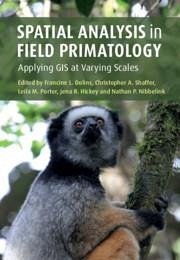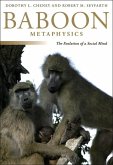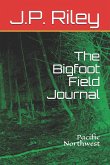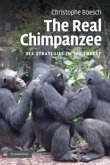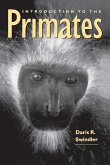Spatial Analysis in Field Primatology
Applying GIS at Varying Scales
Herausgeber: Dolins, Francine L; Nibbelink, Nathan P; Hickey, Jena R; Porter, Leila M; Shaffer, Christopher A
Spatial Analysis in Field Primatology
Applying GIS at Varying Scales
Herausgeber: Dolins, Francine L; Nibbelink, Nathan P; Hickey, Jena R; Porter, Leila M; Shaffer, Christopher A
- Broschiertes Buch
- Merkliste
- Auf die Merkliste
- Bewerten Bewerten
- Teilen
- Produkt teilen
- Produkterinnerung
- Produkterinnerung
A primatologist's guide to using geographic information systems (GIS); from mapping and field accuracy, to tracking travel routes and the impact of logging.
Andere Kunden interessierten sich auch für
![Baboon Metaphysics Baboon Metaphysics]() Dorothy L CheneyBaboon Metaphysics27,99 €
Dorothy L CheneyBaboon Metaphysics27,99 €![The Bigfoot Field Journal The Bigfoot Field Journal]() J. P. RileyThe Bigfoot Field Journal17,99 €
J. P. RileyThe Bigfoot Field Journal17,99 €![The Real Chimpanzee The Real Chimpanzee]() Christophe BoeschThe Real Chimpanzee63,99 €
Christophe BoeschThe Real Chimpanzee63,99 €![Human Senescence Human Senescence]() Douglas E. CrewsHuman Senescence41,99 €
Douglas E. CrewsHuman Senescence41,99 €![Primate Communities Primate Communities]() J. G. Fleagle / Charles Janson / Kaye Reed (eds.)Primate Communities54,99 €
J. G. Fleagle / Charles Janson / Kaye Reed (eds.)Primate Communities54,99 €![For the Love of Lemurs For the Love of Lemurs]() Patricia Chapple WrightFor the Love of Lemurs18,99 €
Patricia Chapple WrightFor the Love of Lemurs18,99 €![Introduction to the Primates Introduction to the Primates]() Daris R SwindlerIntroduction to the Primates36,99 €
Daris R SwindlerIntroduction to the Primates36,99 €-
-
-
A primatologist's guide to using geographic information systems (GIS); from mapping and field accuracy, to tracking travel routes and the impact of logging.
Hinweis: Dieser Artikel kann nur an eine deutsche Lieferadresse ausgeliefert werden.
Hinweis: Dieser Artikel kann nur an eine deutsche Lieferadresse ausgeliefert werden.
Produktdetails
- Produktdetails
- Verlag: Cambridge University Press
- Seitenzahl: 460
- Erscheinungstermin: 25. März 2021
- Englisch
- Abmessung: 241mm x 196mm x 23mm
- Gewicht: 953g
- ISBN-13: 9781107694309
- ISBN-10: 1107694302
- Artikelnr.: 57636430
- Herstellerkennzeichnung
- Libri GmbH
- Europaallee 1
- 36244 Bad Hersfeld
- 06621 890
- Verlag: Cambridge University Press
- Seitenzahl: 460
- Erscheinungstermin: 25. März 2021
- Englisch
- Abmessung: 241mm x 196mm x 23mm
- Gewicht: 953g
- ISBN-13: 9781107694309
- ISBN-10: 1107694302
- Artikelnr.: 57636430
- Herstellerkennzeichnung
- Libri GmbH
- Europaallee 1
- 36244 Bad Hersfeld
- 06621 890
Part I. GPS for Primatologists: Introduction Leila M. Porter; 1. Why place
matters, and its use in primate behavioral and ecological research Francine
L. Dolins; 2. Fundamentals of GPS AND GIS Nathan P. Nibbelink and Joanna
Hatt; 3. 'Next-gen' tracking in primatology: opportunities and challenges
Margaret C. Crofoot; 4. The ethical implications, and practical
consequences, of attaching remote telemetry apparatus to macaques Amy
Klegarth, Agustín Fuentes, Lisa Jones-Engel, Greg Marshall and Kyler
Abernathy; 5. Processing geospatial data in R: a primer Allison Howard and
Roger Mundry; 6. Estimating travel distance and linearity of primate
routes: ideas on how to clean and smooth track data collected with a
handheld GPS Karline R. L. Janmaat, Simone D. Ban and Roger Mundry; Part
II. GIS Analysis in Fine-Scale Space: Introduction Christopher A. Shaffer;
7. Home range analysis: why the methods matter Sarah A. Boyle; 8.
Quantifying resource dispersion in free-ranging bearded sakis in Guyana:
what is a patch? Christopher A. Shaffer; 9. Interpreting small-scale
patterns of ranging by primates: what does it mean, and why does it matter?
Mitchell T. Irwin and Jean-Luc Raharison; 10. Determining the presence of
habitual travel route networks in orangutans (pongo pygmaeus morio) in
Kutai National Park, Borneo Adam O. Bebko; 11. Finding fruit in a tropical
rainforest: a comparison of the foraging patterns of two distinct
fruit-eating primates across years Leila M. Porter, Paul Garber,
Christopher Boesch and Karline R. L. Janmaat; 12. Random walk analyses in
primates Amy L. Schreier and Matt Grove; 13. The use of small-scale spatial
analysis to evaluate primate behavior and welfare in captive settings
Stephen R. Ross and Marisa A. Shender; 14. The promise of spatially
explicit agent-based models for primatology research Anthony Di Fiore; Part
III. GIS Analysis in Broad-Scale Space: Introduction Francine L. Dolins;
15. Modeling niches and mapping distributions: progress and promise of
ecological niche models for primate research Kenneth L. Chiou and Mary E.
Blair; 16. Does reduced habitat quality or increased hunter access explain
defaunation of fragmented forests? Bonobos as a case study Jena R. Hickey
and Michael J. Conroy; 17. Landscape ecology of deforestation processes and
lemur biogeography in Madagascar Travis S. Steffens and Shawn M. Lehman;
18. Quantitative methods for primate biogeography and macroecology Jason M.
Kamilar and Lydia Beaudrot; 19. GIS and GPS techniques in an
ethnoprimatological investigation of St Kitts green monkey (chlorocebus
sabaeus) crop-foraging behavior Kerry M. Dore, Daniel Sewell, Eduardo M.
Mattenet and Trudy R. Turner; 20. Conclusion Francine L. Dolins.
matters, and its use in primate behavioral and ecological research Francine
L. Dolins; 2. Fundamentals of GPS AND GIS Nathan P. Nibbelink and Joanna
Hatt; 3. 'Next-gen' tracking in primatology: opportunities and challenges
Margaret C. Crofoot; 4. The ethical implications, and practical
consequences, of attaching remote telemetry apparatus to macaques Amy
Klegarth, Agustín Fuentes, Lisa Jones-Engel, Greg Marshall and Kyler
Abernathy; 5. Processing geospatial data in R: a primer Allison Howard and
Roger Mundry; 6. Estimating travel distance and linearity of primate
routes: ideas on how to clean and smooth track data collected with a
handheld GPS Karline R. L. Janmaat, Simone D. Ban and Roger Mundry; Part
II. GIS Analysis in Fine-Scale Space: Introduction Christopher A. Shaffer;
7. Home range analysis: why the methods matter Sarah A. Boyle; 8.
Quantifying resource dispersion in free-ranging bearded sakis in Guyana:
what is a patch? Christopher A. Shaffer; 9. Interpreting small-scale
patterns of ranging by primates: what does it mean, and why does it matter?
Mitchell T. Irwin and Jean-Luc Raharison; 10. Determining the presence of
habitual travel route networks in orangutans (pongo pygmaeus morio) in
Kutai National Park, Borneo Adam O. Bebko; 11. Finding fruit in a tropical
rainforest: a comparison of the foraging patterns of two distinct
fruit-eating primates across years Leila M. Porter, Paul Garber,
Christopher Boesch and Karline R. L. Janmaat; 12. Random walk analyses in
primates Amy L. Schreier and Matt Grove; 13. The use of small-scale spatial
analysis to evaluate primate behavior and welfare in captive settings
Stephen R. Ross and Marisa A. Shender; 14. The promise of spatially
explicit agent-based models for primatology research Anthony Di Fiore; Part
III. GIS Analysis in Broad-Scale Space: Introduction Francine L. Dolins;
15. Modeling niches and mapping distributions: progress and promise of
ecological niche models for primate research Kenneth L. Chiou and Mary E.
Blair; 16. Does reduced habitat quality or increased hunter access explain
defaunation of fragmented forests? Bonobos as a case study Jena R. Hickey
and Michael J. Conroy; 17. Landscape ecology of deforestation processes and
lemur biogeography in Madagascar Travis S. Steffens and Shawn M. Lehman;
18. Quantitative methods for primate biogeography and macroecology Jason M.
Kamilar and Lydia Beaudrot; 19. GIS and GPS techniques in an
ethnoprimatological investigation of St Kitts green monkey (chlorocebus
sabaeus) crop-foraging behavior Kerry M. Dore, Daniel Sewell, Eduardo M.
Mattenet and Trudy R. Turner; 20. Conclusion Francine L. Dolins.
Part I. GPS for Primatologists: Introduction Leila M. Porter; 1. Why place
matters, and its use in primate behavioral and ecological research Francine
L. Dolins; 2. Fundamentals of GPS AND GIS Nathan P. Nibbelink and Joanna
Hatt; 3. 'Next-gen' tracking in primatology: opportunities and challenges
Margaret C. Crofoot; 4. The ethical implications, and practical
consequences, of attaching remote telemetry apparatus to macaques Amy
Klegarth, Agustín Fuentes, Lisa Jones-Engel, Greg Marshall and Kyler
Abernathy; 5. Processing geospatial data in R: a primer Allison Howard and
Roger Mundry; 6. Estimating travel distance and linearity of primate
routes: ideas on how to clean and smooth track data collected with a
handheld GPS Karline R. L. Janmaat, Simone D. Ban and Roger Mundry; Part
II. GIS Analysis in Fine-Scale Space: Introduction Christopher A. Shaffer;
7. Home range analysis: why the methods matter Sarah A. Boyle; 8.
Quantifying resource dispersion in free-ranging bearded sakis in Guyana:
what is a patch? Christopher A. Shaffer; 9. Interpreting small-scale
patterns of ranging by primates: what does it mean, and why does it matter?
Mitchell T. Irwin and Jean-Luc Raharison; 10. Determining the presence of
habitual travel route networks in orangutans (pongo pygmaeus morio) in
Kutai National Park, Borneo Adam O. Bebko; 11. Finding fruit in a tropical
rainforest: a comparison of the foraging patterns of two distinct
fruit-eating primates across years Leila M. Porter, Paul Garber,
Christopher Boesch and Karline R. L. Janmaat; 12. Random walk analyses in
primates Amy L. Schreier and Matt Grove; 13. The use of small-scale spatial
analysis to evaluate primate behavior and welfare in captive settings
Stephen R. Ross and Marisa A. Shender; 14. The promise of spatially
explicit agent-based models for primatology research Anthony Di Fiore; Part
III. GIS Analysis in Broad-Scale Space: Introduction Francine L. Dolins;
15. Modeling niches and mapping distributions: progress and promise of
ecological niche models for primate research Kenneth L. Chiou and Mary E.
Blair; 16. Does reduced habitat quality or increased hunter access explain
defaunation of fragmented forests? Bonobos as a case study Jena R. Hickey
and Michael J. Conroy; 17. Landscape ecology of deforestation processes and
lemur biogeography in Madagascar Travis S. Steffens and Shawn M. Lehman;
18. Quantitative methods for primate biogeography and macroecology Jason M.
Kamilar and Lydia Beaudrot; 19. GIS and GPS techniques in an
ethnoprimatological investigation of St Kitts green monkey (chlorocebus
sabaeus) crop-foraging behavior Kerry M. Dore, Daniel Sewell, Eduardo M.
Mattenet and Trudy R. Turner; 20. Conclusion Francine L. Dolins.
matters, and its use in primate behavioral and ecological research Francine
L. Dolins; 2. Fundamentals of GPS AND GIS Nathan P. Nibbelink and Joanna
Hatt; 3. 'Next-gen' tracking in primatology: opportunities and challenges
Margaret C. Crofoot; 4. The ethical implications, and practical
consequences, of attaching remote telemetry apparatus to macaques Amy
Klegarth, Agustín Fuentes, Lisa Jones-Engel, Greg Marshall and Kyler
Abernathy; 5. Processing geospatial data in R: a primer Allison Howard and
Roger Mundry; 6. Estimating travel distance and linearity of primate
routes: ideas on how to clean and smooth track data collected with a
handheld GPS Karline R. L. Janmaat, Simone D. Ban and Roger Mundry; Part
II. GIS Analysis in Fine-Scale Space: Introduction Christopher A. Shaffer;
7. Home range analysis: why the methods matter Sarah A. Boyle; 8.
Quantifying resource dispersion in free-ranging bearded sakis in Guyana:
what is a patch? Christopher A. Shaffer; 9. Interpreting small-scale
patterns of ranging by primates: what does it mean, and why does it matter?
Mitchell T. Irwin and Jean-Luc Raharison; 10. Determining the presence of
habitual travel route networks in orangutans (pongo pygmaeus morio) in
Kutai National Park, Borneo Adam O. Bebko; 11. Finding fruit in a tropical
rainforest: a comparison of the foraging patterns of two distinct
fruit-eating primates across years Leila M. Porter, Paul Garber,
Christopher Boesch and Karline R. L. Janmaat; 12. Random walk analyses in
primates Amy L. Schreier and Matt Grove; 13. The use of small-scale spatial
analysis to evaluate primate behavior and welfare in captive settings
Stephen R. Ross and Marisa A. Shender; 14. The promise of spatially
explicit agent-based models for primatology research Anthony Di Fiore; Part
III. GIS Analysis in Broad-Scale Space: Introduction Francine L. Dolins;
15. Modeling niches and mapping distributions: progress and promise of
ecological niche models for primate research Kenneth L. Chiou and Mary E.
Blair; 16. Does reduced habitat quality or increased hunter access explain
defaunation of fragmented forests? Bonobos as a case study Jena R. Hickey
and Michael J. Conroy; 17. Landscape ecology of deforestation processes and
lemur biogeography in Madagascar Travis S. Steffens and Shawn M. Lehman;
18. Quantitative methods for primate biogeography and macroecology Jason M.
Kamilar and Lydia Beaudrot; 19. GIS and GPS techniques in an
ethnoprimatological investigation of St Kitts green monkey (chlorocebus
sabaeus) crop-foraging behavior Kerry M. Dore, Daniel Sewell, Eduardo M.
Mattenet and Trudy R. Turner; 20. Conclusion Francine L. Dolins.

